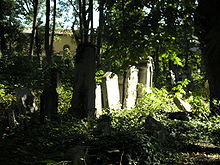Jewish cemetery in Währing

Jewish cemetery in Währing
|
|
| Details | |
|---|---|
| Established | 1784 |
| Location | Döbling, Vienna |
| Country | Austria |
| Type | Jewish (closed) |
| Style | Biedermeier |
| No. of graves | 5,800 – 7,300 |
The Jewish Cemetery in Währing, opened in 1784, was the main burial site for members of the Israelitische Kultusgemeinde Wien. Besides the St. Marx Cemetery it is the last remaining cemetery of Vienna in the Biedermeier style. After its closure in the 1880s, it was partially destroyed during the time of the Third Reich, and is now only partly accessible due to its deteriorating condition. A long-running debate over the restoration of the cemetery has been taking place since 2006 between politicians of the federal and local levels as well as experts.
Originally the cemetery was part of the Viennese suburb of Währing. Today, however, due to boundary changes, the cemetery, despite its name, is no longer part of the 18th Vienna district of Währing, but belongs to Döbling, the 19th district. The entry is at No 3 Schrottenbachgasse.
Due to the sanitation ordinance of the Holy Roman Emperor Joseph II, every graveyard in Vienna within the city walls had to be closed. In place of the old local graveyards that had developed around the parish churches, new graveyards were constructed outside the city walls. The Jewish community was also affected by this measure, as they maintained a cemetery in the Seegasse (Roßau). This cemetery was closed. For this reason, in 1784 the Jewish community acquired a 2-hectare plot of land next to the newly constructed General Cemetery of Währing; there, in the same year, they opened the new Jewish cemetery, demarcated by a wall. Originally, the cemetery consisted only of the part to the west of the entrance; however, it was twice expanded towards the east through the purchase of more land. Until the completion of the Jewish part of the Zentralfriedhof in 1879 approximately 8000 to 9000 graves were constructed here. Unlike at the Jewish cemetery in Roßau, where only Hebrew inscriptions may be found, in the Währing cemetery gravestones with Hebrew as well as German writing exist. A last few, occasional burials took place in the family vaults in the late 1880s. After that, no more burials took place at the cemetery. Around 1900 an avenue of lime trees was planted in the middle of the unused cemetery. This is a sign of how liberal the Jewish community in Vienna at the time was, as lime trees planted next to priests' graves are supposed to dissolve the separation between these graves and the surrounding graves in the traditional Jewish mindset.
...
Wikipedia
